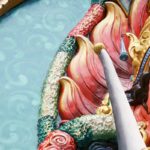Sources
The silk comes from Mysore. The zari from Surat. The dye is either natural or more often, chemical. The design comes from tradition. The weave by an ecosystem of hands, aided by eye and unwavering concentration.
Zari
A zari– for Kanchipuram weaves– is a red thread that is wrapped with beaten silver, then dipped into 22-carat gold. Kanchipuram sarees are distinguished by original silver and gold. “Tested zari” does not have this authentic quality and sarees made with tested zari are therefore cheaper. How can you find out if it is real zari? Rub the zari on a slate (a chalkboard). Tested zari will not retain its colour.
Kanchipuram versus other types of silk
There are many weaving regions in Tamilnadu: Arani, Dharmavaram, Salem, Coimbatore, and Kanchipuram. Weavers in Kanchipuram think that their weaves are the best, a claim borne out by the market. Arani and Dharmavaram sarees use lighter silks, not the heavy “murukku pettu” (three pieces of thread twisted together like a South Indian snack called ‘murukku’) silks of Kanchipuram.
Coimbatore and Chettinad are famous for their cottons. For Tamilnadu silk sarees, you cannot do better than Kanchipuram, which is why it has a Geographical Indication (GI) tag.




